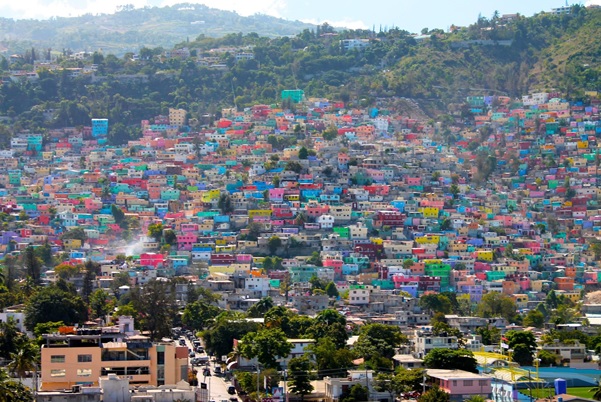 Source: Clare Hopping, 2014
Source: Clare Hopping, 2014Port au Prince is a coastal city and capital of the developing nation of Haiti. The population is estimated to be 3.3 million, with an average density of 140,000 people per square mile (IHSI, 2015). Primary challenges include ineffective governance, and a large proportion of urban residents living in slums.
Port au Prince lies within the hurricane belt in the Atlantic Ocean, and experiences a long wet season with consistently high temperatures (ClimaTemps, 2015). Mudslides and flooding are common, in part due to the depletion of 98% of Haitian forests (Than, 2010).
Port au Prince is challenged in its ability to adapt to climate change. There is a lack of infrastructure, building codes, and water services. Nearly 70% of Haitians lack direct access to clean water. Urban sanitation access is limited and 25% of the population openly defecates in the open, contaminating the water supply (WHO/UNICEF, 2015). Haiti is the only country that has had a decrease in sanitation services between 1995 and 2010 (World Bank, 2010). Cholera has caused 9,000 deaths and infected an additional 700,000 people (United Nations, 2010). Port au Prince has poor governance, a lack of data, and a dependence on international aid (Roodman, 2010). Access to water, and the ability to cope with water-related disasters are of primary concern to Port au Prince’s long-term stability.
The DINEPA (the central Port-au-Prince water authority) and the MSPP (Ministry of Public Health) are currently faced with failing infrastructure and inadequate resources to ensure centralized water delivery and wastewater treatment for its citizens. A framework for unifying the public and private sectors would improve the distribution and resiliency of potable water and wastewater treatment centers. Such partnerships would create and enforce water standards through training and financial support. Public-private partnerships, if managed well, offer the two-fold benefit of bolstering economic development by performance of local utility companies, and equity outcomes of water services through targeted government subsidies, enabling water services to be sold at a reduced fixed rate to the poor households.
In order to prepare for the increasing likelihood of flood recurrence, which has had disastrous implications on the population in the past, Port au Prince must begin considering long-term land use changes in flood-prone areas. The Directorate of Civil Protection, the body responsible for disaster management, must incentivize a transition from living quarters in flood-prone areas to designated safe zones. This can be done through the use of redevelopment incentives, enhanced public utility benefits in new locations, and the transfer of development rights to relocated households. The enforcement of new building codes is critical to the enhancement of long-term resilience, but will require external assistance and training from organizations with expertise.
In the short-term, Port au Prince must develop a disaster evacuation plan in order to mitigate risk from extreme weather events. This plan must include an early-warning system, zone-based evacuation routes, and access to emergency supplies. While water is only one of Haiti’s many challenges, these steps will help ensure improvement of both access to water, and protection from water-related disasters.
This article is a product of Professor Shagun Mehrotra’s Climate Change and Cities class. Analysis is based on the Framework for City Climate Risk Assessment and Climate Change and Cities:First Assessment Report of the Urban Climate Change Research Network. Views expressed are entirely those of the authors.
References
ClimaTemps. Port-au-Prince Climate and Temperature. (2015). Retrieved November 6, 2015, from http://www.haiti.climatemps.com/
Institut Haitien De Statistique et D’informatique (IHSI). 2015. Direction Des Statistiques Demograhiques et Sociales. Retrieved November 6, 2015, from http://www.ihsi.ht/pdf/projection/Estimat_PopTotal_18ans_Menag2015.pdf
Roodman, D. Center for Global Development. (2015, January 15). Haiti Aid Facts. Retrieved November 10, 2015, from http://www.cgdev.org/blog/haiti-aid-facts
Than, K. (2010, January 15). Haiti Earthquake, Deforestation Heighten Landslide Risk. Retrieved November 6, 2015, from http://news.nationalgeographic.com/news/2010/01/100114-haiti-earthquake-landslides/
United Nations. The struggle to help hurricane-hit Caribbean continues, UN relief wing says. (2008, September 8). Retrieved November 6, 2015, from http://www.un.org/apps/news/story.asp?NewsID=27977#.Vj0DOa6rQzU
WHO/UNICEF Joint Monitoring Programme for Water Supply and Sanitation. (2015). Haiti: estimates on the use of water sources and sanitation facilities. Retrieved November 6, 2015, from http://www.wssinfo.org/documents/?tx_displaycontroller%5Btype%5D=country_files&tx_displaycontroller%5Bsearch_word%5D
The World Bank. Haiti Data. (2014). Retrieved November 6, 2015, from http://data.worldbank.org/country/haiti